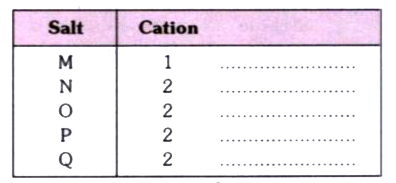A white sodium salt dissolves in water to give a solution which is neutral to litmus.When silver nitrate solution is added to the solution, a white precipitate is obtained which does not dissolve in dilute HNO3.The anion is
CO2−3
Cl−
SO2−3
S2−
The correct Answer is:B
Step by step video & image solution for A white sodium salt dissolves in water to give a solution which is neutral to litmus.When silver nitrate solution is added to the solution, a white precipitate is obtained which does not dissolve in dilute HNO_(3).The anion is by Chemistry experts to help you in doubts & scoring excellent marks in Class 12 exams.
Updated on:21/07/2023Topper's Solved these Questions
- QUALITATIVE ANALYSIS (ANION)BOOK - RESONANCE ENGLISHCHAPTER - QUALITATIVE ANALYSIS (ANION)EXERCISE - Exercise-3
10 Videos
- QUALITATIVE ANALYSIS (ANION)BOOK - RESONANCE ENGLISHCHAPTER - QUALITATIVE ANALYSIS (ANION)EXERCISE - Additional Problems for Self Practice (APSP)
30 Videos
- QUALITATIVE ANALYSIS (ANION)BOOK - RESONANCE ENGLISHCHAPTER - QUALITATIVE ANALYSIS (ANION)EXERCISE - Exercise-1
59 Videos
- QUALITATIVE ANALYSISBOOK - RESONANCE ENGLISHCHAPTER - QUALITATIVE ANALYSISEXERCISE - INORGANIC CHMISTRY(Qualitative analysis)
35 Videos
- QUALITATIVE ANALYSIS PART 1BOOK - RESONANCE ENGLISHCHAPTER - QUALITATIVE ANALYSIS PART 1EXERCISE - A.L.P
39 Videos
Similar Questions
An example of a salt dissolved in water to give acidic solution is
View SolutionIf silver nitrate solution is added to a salt solution and a yellow precipitate is obtained the salt may contain
View SolutionSolutions of silver nitrate and sodium chloride react to form a white precipitate of
View SolutionSilver nitrate reacts with sodium oxalate to give white precipitate of
View SolutionIdentify the cation in each of the following case
Ammonium hydroxide solution when added to the solution B gives white precipitate which dissolves in excess
View SolutionSalts M, N, O, P and Q undergo reactiom (i) to (v) respectively.
Identify the cation present in these salts on the basis of these reaction. Tabulate your answer in the format given below.
1. When sodium hydroxide solution is added to the salt M, and heated strongly a colourless gas with a pungent smell is evolved which turm red litmus paper blue and gives dense white fumes with a moist glass rod with hydrochloric acid.
2. Addition of dilute hydrochloric acid to a solution of N gives a thick white precipitate which is soluble in hot water.
3. When ammonium hydroxide solution is added to the solution of 0 a light blue precipitate is obtained which is soluble in excess of ammonium hydroxide to form an inteme deep blue solution.
4. When ammonium hydroxide solution is added to the solution of P reddish brown (mustard colour) precipitate is obtained which ,is insoluble even in the excess of ammonium hydroxide solution.
5. When sodium hydroxide solution is added to the solution of Q a which coloured gelatinous precipitate is obtained which is soluble in excess of sodium hydroxide to form a clear solution

View SolutionAgNO3 solution will not give white precipitate with
View SolutionIdentify the cations in each of the following case :
NH4OH Solution when added to the Solution (B) gives white ppt which does not dissolve in excess.
View SolutionWhen a KI solution is added to a metal nitrate, a black precipitate is produced which dissolves in an excess of KI to give an organge solution. The metal ion is:
View SolutionAn unknown mixture contains one or two of the following: CaCO3,BaCl2,AgNO3,Na2SO4,ZnSO4andNaOH. The mixture is completely soluble in water and solution gives pink colour with phenolphthalein. When dilute hydrochloric acid is gradually added to the solution, a precipitate is formed which dissolved with further addition of the acid.
Q. The aqueous solution of mixture gives white precipitate with dil. HCl which dissolves in excess of dil HCl . it confirms.
View Solution